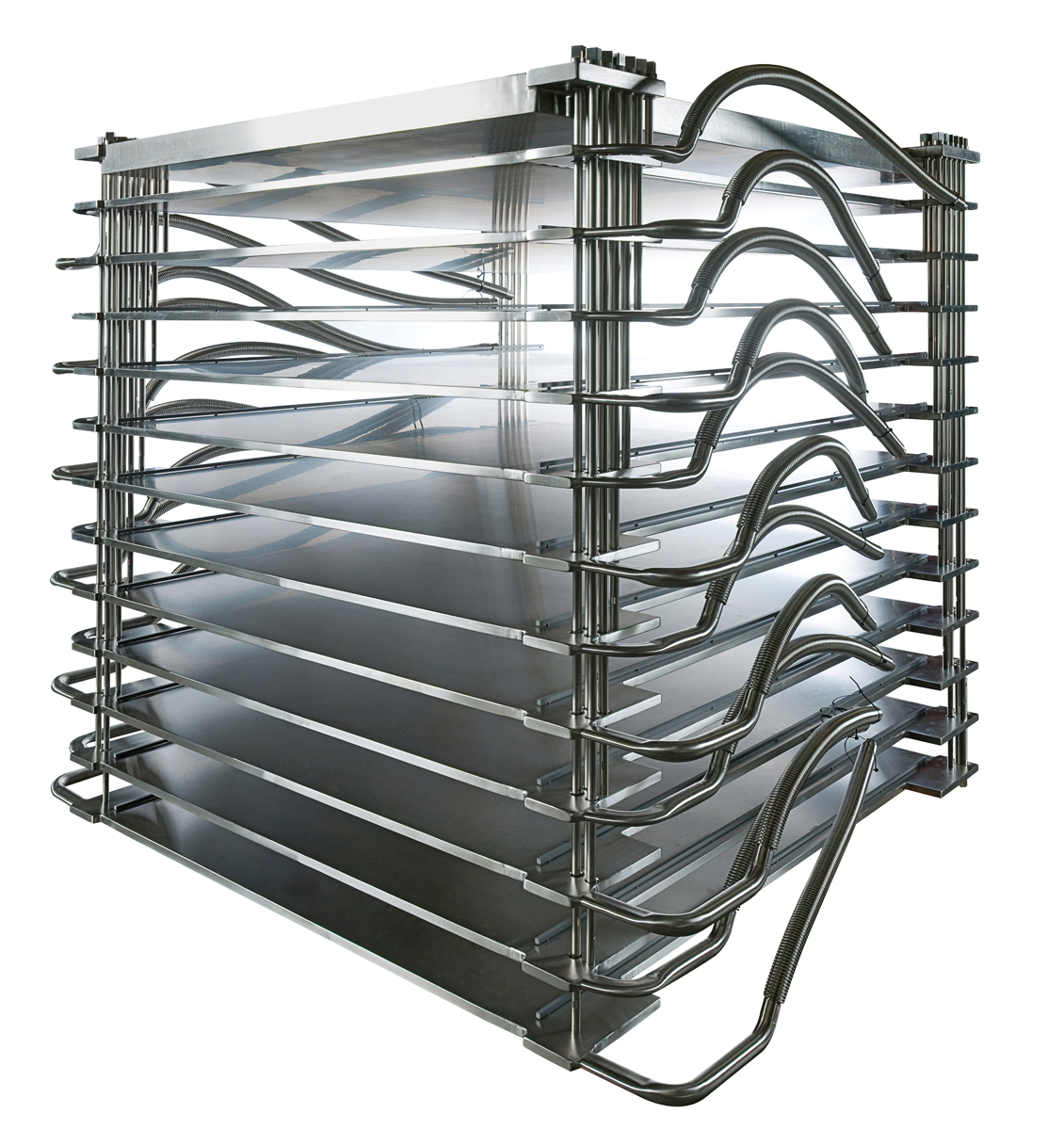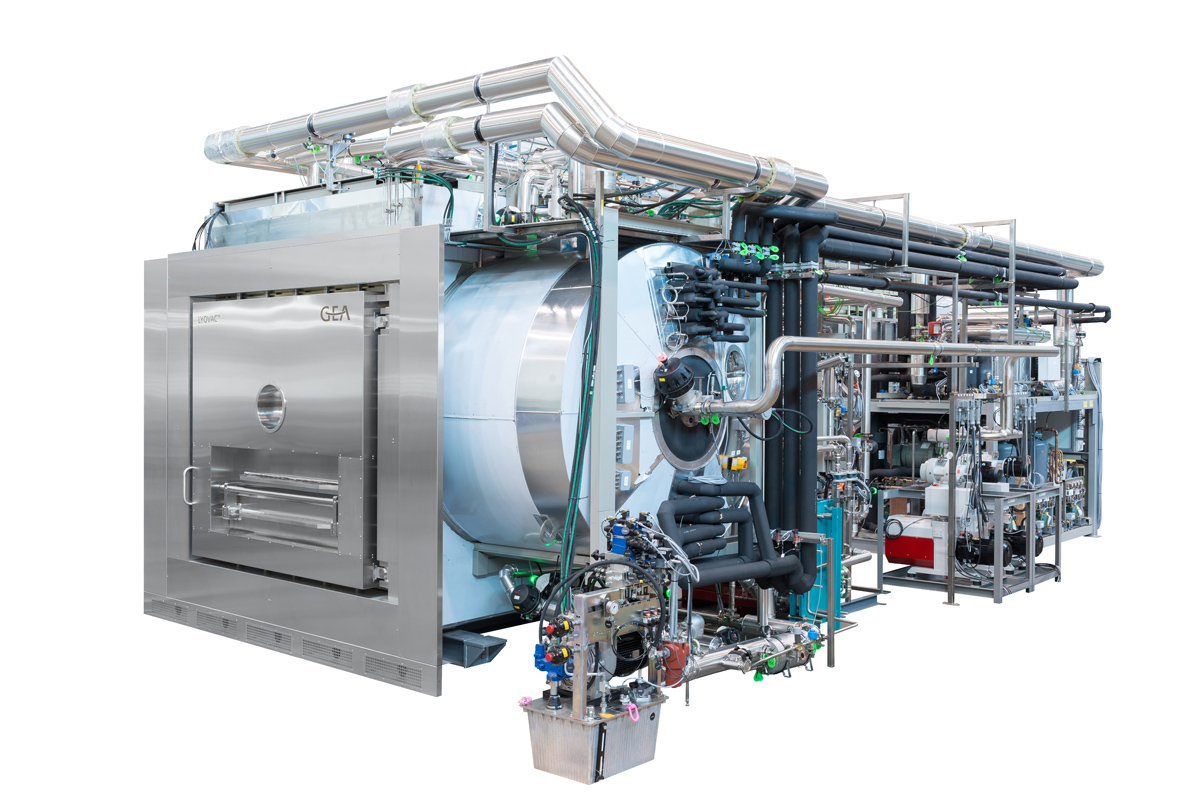Lyophilisation or freeze drying is widely used during the production of pharmaceutical and biological products to increase their stability. Developed during the 1940s, lyophilisation produces a dry product (cake) that can be readily reconstituted to its original form by adding water. It prolongs product shelf-life by impeding the chemical, microbiological and physical degradation pathways that arise in the presence of moisture, particularly when long periods of storage and/or transit prior to use are involved.
The lyophilisation process comprises three main stages: freezing (solidification), primary drying (ice sublimation) and secondary drying (moisture desorption). The specific process conditions applied during the freezing step will determine the structure of the resulting product cake. The size of the ice crystals will determine the sublimation speed during primary drying. The larger the ice crystals, the faster the primary drying process will be, owing to reduced mass flow resistance. The nucleation of ice crystals (the initial stage of ice formation during freezing) is, however, a naturally spontaneous and protracted process. As such, forcing ice crystals to nucleate at a specific temperature, rate and time can improve the homogeneity of the batch and reduce the cycle duration. The temperature profile after ice nucleation is critical for subsequent ice crystal growth.
Spontaneous and uncontrolled nucleation is random and time-consuming. Ice-nucleation temperatures in individual vials can vary from –10 to –20 °C, resulting in nucleation durations of up to an hour for the entire batch and differing crystal structures. It was important, therefore, to develop a method to induce nucleation — particularly for industrial-scale freeze dryers — to overcome this problem.
LYOSPARK, a patent pending technology from GEA, ensures inter-batch homogeneity, improves process repeatability and enhances both the appearance and quality of the final product. A new GMP-compliant SCADA recipe has been designed to perform controlled nucleation without the need for human intervention. In addition, a validation protocol has been implemented to ensure the correct functionality of the application.
It is important to highlight that cycle time reduction is not constant; it is highly dependent on the specifics of the product being freeze dried. However, time reductions of up to 30% have been achieved during the development and testing of the new technology.
A practical approach to controlled nucleation
The two currently available techniques to control nucleation are “ice fog” (such as Veriseq by Linde) and “depressurisation” (ControLyo, developed by Praxair). The ice fog technique, as with any other freeze drying recipe, involves cooling the vials to the desired temperature (below the equilibrium freezing point) and reducing the pressure. To induce nucleation, however, cold nitrogen gas is sprayed through a liquid nitrogen heat exchanger into the chamber (or used to cool water that is then injected into the chamber). The cold gas in the chamber subsequently forms an ice fog, which is forced into the vials and initiates ice crystallisation in the supercooled solution.
By contrast, the depressurisation technique involves reducing the product temperature in the vials to a selected value, followed by pressurisation of the freeze dryer chamber with an inert gas such as nitrogen or argon. When thermal equilibrium has been achieved, the excess pressure is released, causing ice crystals to form at the top of the solution and propagate throughout the vials within seconds.
Whether by ice crystal injection or depressurisation, however, there is no material difference regarding the initial ice structure: both techniques are effective if the crystal formation has a common starting point and post-nucleation crystal growth is controlled.

For more than half a century, GEA has designed and manufactured freeze dryers for the pharmaceutical and biotech industries
Controlled depressurisation
To develop and verify a new technology to control nucleation, several experiments were done at GEA’s Group liquid dosage application site near Cologne, Germany. Initial tests were based on established procedures.1 Geidobler describes a well-controlled depressurisation followed by abrupt venting of the chamber through the condenser venting valve at 3.7 mbar absolute pressure during the freezing step as a trigger for immediate nucleation in all vials of the batch.
The first tests were done on a LYOVAC FCM2 laboratory scale freeze dryer (GEA Group, Köln-Hürth, Germany). The batch consisted of vials (DIN 20R) filled with a 5% (w/v) sucrose solution prepared with distilled water. Prior to initiation, the freezing point and supercooling temperature of the sucrose solution were determined to define suitable recipe parameters.
During the lyophilisation process, after reaching the set freezing temperature, a holding time was initiated to supercool the solution in each vial to the same degree. Subsequently, an abrupt venting of the chamber was done through a 1.5-inch condenser port. Initially, the venting pressure was chosen based on Geidobler’s theory.1
During those experiments, Geidobler’s theory was partially verified. However, numerous experiments showed early ice nucleation, prior to the venting procedure, as well as occasions when ice nucleation was completely absent, even after the venting procedure. It was thus concluded that the theorised value for the venting pressure could not as such be confirmed.
For those reasons and the fact that a clean process was required that avoided any direct, unfiltered current from the condenser to the freeze dryer chamber, a second test series was done during which the experimental set-up was altered.
A cooling trap (cooled pipe) with a manual valve was mounted onto the freeze drying chamber. Any remaining (atmospheric) moisture in the chamber was therewith confined within the cooling trap. During the venting step, cold gas from the condenser (nitrogen) was filtered and blown at speed through the cooled pipe into the chamber. Ice crystals were removed from the inner surface of the cooled pipe, carried with the gas flow into the product chamber and, finally, into the vials to serve as the nucleation source.
Using this experimental set-up, several tests were done with the same sucrose solution and with 3% (w/v) mannitol solutions to further increase the comparability of the test results. After several experiments, a sterile filter was added to the venting set-up to examine its influence on the air stream.
These experiments repeatedly showed successfully controlled nucleation. Therefore, additional experiments were done using the newly developed controlled nucleation technology on a LYOVAC FCM75-l (GEA Group) pilot-scale freeze dryer (5 m² shelf area) as well as a LYOVAC FCM800 (GEA Group) production-scale model (42 m² shelf area).

Conclusion
“A significant challenge for the commercial implementation of LYOSPARK nucleation technology is to ensure the aseptic environment of ice injection. Penetration inside vials has already been validated at several chamber volumes,” observes Vincenzo Esposito, Product Manager, Lyophilisation, at GEA.
A recent case study at GEA’s lab involved the use of LYSOSPARK technology on a product requiring a particularly long cycle time. By monitoring the homogeneity and growth of the crystals, it was possible to accelerate drying times (avoiding glass breakage), reduce the entire cycle time and improve the quality of the cake.
In summary, LYOSPARK controlled nucleation technology facilitates uniform ice crystal formation in laboratory and production-scale freeze dryers with a minimum degree of supercooling. This is reflected in more consistent and larger ice crystal sizes with a more open product structure. As a result, faster drying and reconstitution times can be achieved.
Reference
- R. Geidobler, “A New Approach to Achieve Controlled Ice Nucleation of Supercooled Solutions During the Freezing Step in Freeze Drying,” Journal of Pharmaceutical Sciences 101(12), 4409–4413 (2012).





